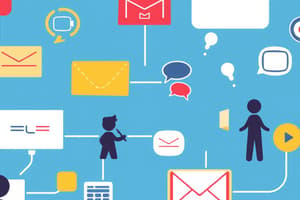Podcast
Questions and Answers
Which technological advancement directly contributed to a reduction in the need for farm workers?
Which technological advancement directly contributed to a reduction in the need for farm workers?
- The use of machines instead of human or animal power in farming. (correct)
- The development of richer fuels for steam engines.
- The invention of the electric telegraph.
- Improvements in metal production.
What was a significant impact of advancements in metals and fuels during the industrialization period?
What was a significant impact of advancements in metals and fuels during the industrialization period?
- It facilitated the development of steam engines, factories, and ships. (correct)
- It increased the dependence on human and animal power in farming.
- It led to the creation of new forms of communication like the Morse code.
- It reduced the use of computers in managing information.
What is the primary characteristic of the Electronic/Information Age, as described in the text?
What is the primary characteristic of the Electronic/Information Age, as described in the text?
- It is defined by a reduction in the importance of information technology.
- It is characterized by a decline in technological advancements.
- It is focused on agricultural development and growth.
- It is an economy based on the computerization of information. (correct)
Samuel F.B. Morse, with Alfred Vail, developed a system for representing letters, numbers, and punctuation marks using which method?
Samuel F.B. Morse, with Alfred Vail, developed a system for representing letters, numbers, and punctuation marks using which method?
Which of the following is a core aspect of information literacy?
Which of the following is a core aspect of information literacy?
What is the first step in the process of being information literate, as described in the material?
What is the first step in the process of being information literate, as described in the material?
Which action would best demonstrate the 'Find' component of information literacy?
Which action would best demonstrate the 'Find' component of information literacy?
What is one way to describe information literacy's effects on learning and cognitive processes?
What is one way to describe information literacy's effects on learning and cognitive processes?
Which characteristic is associated with the Mesolithic period?
Which characteristic is associated with the Mesolithic period?
What does the term 'Paleolithic' refer to?
What does the term 'Paleolithic' refer to?
What is the primary focus of 'New Media' in the context of the provided content?
What is the primary focus of 'New Media' in the context of the provided content?
What is a key characteristic of 'hot media' according to the content?
What is a key characteristic of 'hot media' according to the content?
What is the main outcome of the increased agricultural output of the agricultural period?
What is the main outcome of the increased agricultural output of the agricultural period?
What is the primary characteristic associated with the Neolithic period, based on the provided information?
What is the primary characteristic associated with the Neolithic period, based on the provided information?
According to the provided definitions, what is the primary goal of information literacy?
According to the provided definitions, what is the primary goal of information literacy?
What is a defining feature of 'cold media,' according to the provided text?
What is a defining feature of 'cold media,' according to the provided text?
What is the primary goal of media and information literacy?
What is the primary goal of media and information literacy?
Which of the following best describes 'information literacy'?
Which of the following best describes 'information literacy'?
Which of the following is considered a basic type of communication?
Which of the following is considered a basic type of communication?
What does 'technology literacy' primarily entail?
What does 'technology literacy' primarily entail?
When considering communication, what is the primary aim of exchanging information and ideas?
When considering communication, what is the primary aim of exchanging information and ideas?
In Media and Information Literacy, what is the significance of examining media content critically?
In Media and Information Literacy, what is the significance of examining media content critically?
Which action is most closely related to practicing information literacy?
Which action is most closely related to practicing information literacy?
Which skill demonstrates an understanding of both information and technology literacy?
Which skill demonstrates an understanding of both information and technology literacy?
What is the purpose of using Boolean terms like AND, OR, and NOT in search strategies?
What is the purpose of using Boolean terms like AND, OR, and NOT in search strategies?
Which broadcasting method started with the Theatre Phone system in 1881?
Which broadcasting method started with the Theatre Phone system in 1881?
When did Radio Broadcasting begin commercially?
When did Radio Broadcasting begin commercially?
What is a primary method information literates use to evaluate information sources?
What is a primary method information literates use to evaluate information sources?
What technological advancement began experimentally in 1925?
What technological advancement began experimentally in 1925?
What do radio networks primarily facilitate?
What do radio networks primarily facilitate?
What is one objective of an information literate when applying information?
What is one objective of an information literate when applying information?
What is the main focus of evaluating sources of information?
What is the main focus of evaluating sources of information?
What is the primary focus of media literacy?
What is the primary focus of media literacy?
Which of the following describes the concept of technological determinism?
Which of the following describes the concept of technological determinism?
Marshall McLuhan's statement 'The medium is the message' implies what about society’s adaptation to technology?
Marshall McLuhan's statement 'The medium is the message' implies what about society’s adaptation to technology?
What age is characterized by oral culture and storytelling?
What age is characterized by oral culture and storytelling?
Which of the following represents traditional media?
Which of the following represents traditional media?
What role does feedback play in communication?
What role does feedback play in communication?
Which of the following best describes information in the context of communication?
Which of the following best describes information in the context of communication?
How does media evolution impact society?
How does media evolution impact society?
What is the primary function of television broadcasting, according to the provided text?
What is the primary function of television broadcasting, according to the provided text?
Which of the following media technologies initially used coaxial cables for transmission?
Which of the following media technologies initially used coaxial cables for transmission?
Which media technology was the first introduced commercially, according to the provided text?
Which media technology was the first introduced commercially, according to the provided text?
How does the provided text define "media"?
How does the provided text define "media"?
Which of the following is NOT a characteristic of technology mentioned in the provided text?
Which of the following is NOT a characteristic of technology mentioned in the provided text?
Which media technology combines aspects of traditional radio and television broadcasting?
Which media technology combines aspects of traditional radio and television broadcasting?
What is the primary purpose of Direct Satellite Broadcasting (DBS)?
What is the primary purpose of Direct Satellite Broadcasting (DBS)?
What is the main difference between television broadcasting and radio broadcasting?
What is the main difference between television broadcasting and radio broadcasting?
Flashcards
Communicator (Sender)
Communicator (Sender)
The person or entity initiating a communication process, responsible for creating and transmitting the message.
Message
Message
The information, idea, or thought conveyed by the communicator.
Medium
Medium
The channel through which the message travels from the sender to the receiver.
Receiver
Receiver
Signup and view all the flashcards
Feedback
Feedback
Signup and view all the flashcards
Media Literacy
Media Literacy
Signup and view all the flashcards
Pre-Historic Technology
Pre-Historic Technology
Signup and view all the flashcards
Traditional Media
Traditional Media
Signup and view all the flashcards
Information Literacy
Information Literacy
Signup and view all the flashcards
Technology Literacy
Technology Literacy
Signup and view all the flashcards
Media and Information Literacy
Media and Information Literacy
Signup and view all the flashcards
Communication
Communication
Signup and view all the flashcards
Verbal Communication
Verbal Communication
Signup and view all the flashcards
Non-verbal Communication
Non-verbal Communication
Signup and view all the flashcards
Examining media content critically
Examining media content critically
Signup and view all the flashcards
Using media for democratic and intercultural discussions
Using media for democratic and intercultural discussions
Signup and view all the flashcards
Paleolithic (Old Stone Age)
Paleolithic (Old Stone Age)
Signup and view all the flashcards
Mesolithic
Mesolithic
Signup and view all the flashcards
Neolithic
Neolithic
Signup and view all the flashcards
Hot Media
Hot Media
Signup and view all the flashcards
Cold Media
Cold Media
Signup and view all the flashcards
Industrial Age
Industrial Age
Signup and view all the flashcards
Agricultural Age
Agricultural Age
Signup and view all the flashcards
Boolean term AND
Boolean term AND
Signup and view all the flashcards
Boolean term OR
Boolean term OR
Signup and view all the flashcards
Boolean term NOT
Boolean term NOT
Signup and view all the flashcards
Theatre Phone
Theatre Phone
Signup and view all the flashcards
Radio Broadcasting
Radio Broadcasting
Signup and view all the flashcards
Television Broadcasting
Television Broadcasting
Signup and view all the flashcards
Evaluating information
Evaluating information
Signup and view all the flashcards
Applying information
Applying information
Signup and view all the flashcards
Identifying Information Needs
Identifying Information Needs
Signup and view all the flashcards
Finding Information
Finding Information
Signup and view all the flashcards
The Information Age
The Information Age
Signup and view all the flashcards
Mechanization in Farming
Mechanization in Farming
Signup and view all the flashcards
Importance of New Materials and Energy
Importance of New Materials and Energy
Signup and view all the flashcards
Morse Code
Morse Code
Signup and view all the flashcards
What's media?
What's media?
Signup and view all the flashcards
Typology of Information
Typology of Information
Signup and view all the flashcards
Factual Information
Factual Information
Signup and view all the flashcards
Subjective Information
Subjective Information
Signup and view all the flashcards
Current Information
Current Information
Signup and view all the flashcards
Historical Information
Historical Information
Signup and view all the flashcards
Scholarly Information
Scholarly Information
Signup and view all the flashcards
Popular Information
Popular Information
Signup and view all the flashcards
Study Notes
UNIT 1: Introduction to Media and Information Literacy
- Media and Information Literacy aims to educate citizens about media and information systems in a democratic society. It helps citizens understand how these systems work and assess the quality of content.
- Communication is the sharing of information or opinions using language, symbols, or mannerisms—essentially, exchanging ideas to achieve understanding.
- Basic Communication Types include verbal (signs, gestures, symbols) and nonverbal (oral, written).
- Elements of Communication include sender, message, medium, receiver, and feedback.
- Communication is influenced by information and media—tools for disseminating and processing information.
- Information is knowledge or data from experiences or research.
- Media Literacy involves analyzing, evaluating, and producing communication in various media formats.
- Roles of media include understanding the conditions under which media operates.
UNIT 2: The Evolution of Traditional Media
- Media forms and technology have evolved over time.
- Marshall McLuhan's concept "the medium is the message" highlights how society adapts to technological advancements, impacting culture and history.
- Technological determinism posits that societal changes are driven by advances in communication technology.
- Media History includes the Tribal Age (oral culture, storytelling, multi-sensory experiences).
UNIT 3: Information Literacy
- Information Literacy is the ability to identify, locate, evaluate, organize, and use information effectively.
- Information Literacy is crucial for ethical and effective communication and is essential for problem-solving and critical thinking.
- Components of Information Literacy include identifying information needs, locating information resources, evaluating information, and applying information to various situations/tasks.
UNIT 4: Types of Media
- Media refers to tools and methods used to disseminate information.
- Types of Media include print (books, newsletters, magazines), broadcast (radio, television, telephone), and new media (internet-based content).
- Print media conveys information through physically printed materials.
- Broadcast Media involves transmitting information using electronic signals, encompassing various formats like telephone, radio, and television.
- New Media involves content accessible through the internet and is characterized by interactivity and access to diverse information resources.
Studying That Suits You
Use AI to generate personalized quizzes and flashcards to suit your learning preferences.




